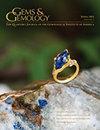Mineral Inclusions in Sapphire from Basaltic Terranes in Southern Vietnam: Indicator of Formation Model
IF 1.6
3区 地球科学
Q2 MINERALOGY
引用次数: 2
Abstract
GEMS & GEMOLOGY WINTER 2020 Since the late 1980s, sapphire mines in southern Vietnam have supplied significant quantities of gem materials to the jewelry industry (figure 1). Commercial gem mines in southern Vietnam have been located in four main areas, including Dak Nong, Di Linh, Binh Thuan, and Krong Nang (figure 2) (Smith et al., 1995; Long et al., 2004; Garnier et al., 2005; Izokh et al., 2010; Vu, 2010, 2018). Specifically, the first discovery of abundant gem sapphires was in Dak Nong, followed by Di Linh, Binh Thuan, and Krong Nang, respectively. These sapphires accumulated in Upper-Pleistocene to Quaternary alluvial deposits. In 2017, we carried out field trips in southern Vietnam encompassing Binh Thuan Province, Di Linh (Lam Dong Province), Dak Nong Province, and Krong Nang (Dak Lak Province), where sapphire samples were collected directly from the mines (see figure 2). Gem mining activities in these areas are conducted by a few local miners. Pits are dug with basic tools before washing and hand picking along streams by artisanal miners (figure 3), and mines worked by machinery (figure 4) can also be found. Sapphires in this region usually range from dark blue to bluish green, yellowish green to green, with rare yellow sapphire. The natural intense blue sapphire is the best known and has been specifically recovered from the Dak Nong and Di Linh gem fields (figure 1, left). Other colors such as bluish green and yellowish green to green are common, particularly in the Binh Thuan and Krong Nang gem fields, respectively (figure 1, right). However, these sapphire varieties are generally heat treated for color enhancement. In addition, trapiche-type sapphires (figure 5) are sometimes found in these gem fields.越南南部玄武岩阶地蓝宝石中的矿物包裹体:形成模式的指示
自20世纪80年代末以来,越南南部的蓝宝石矿山为珠宝行业提供了大量的宝石材料(图1)。越南南部的商业宝石矿山位于四个主要地区,包括Dak Nong, Di Linh, Binh Thuan和Krong Nang(图2)(Smith等,1995;Long et al., 2004;Garnier et al., 2005;Izokh et al., 2010;Vu, 2010, 2018)。具体来说,第一次发现丰富的宝石蓝宝石是在德农,其次是迪林、平顺和克朗南。这些蓝宝石聚集在上更新世至第四纪冲积矿床中。2017年,我们在越南南部进行了实地考察,包括平顺省、迪林省(林东省)、德农省和克朗省(德湖省),在那里直接从矿山收集蓝宝石样本(见图2)。这些地区的宝石开采活动由一些当地矿工进行。手工矿工先用基本工具挖坑,然后清洗,然后沿着溪流手工采摘(图3),也可以找到用机器开采的矿井(图4)。该地区的蓝宝石通常从深蓝色到蓝绿色,黄绿色到绿色,有罕见的黄色蓝宝石。天然深蓝蓝宝石是最著名的,特别是从Dak Nong和Di Linh宝石矿中开采出来的(图1,左)。其他颜色,如蓝绿色和黄绿色到绿色是常见的,特别是在Binh Thuan和Krong Nang的宝石场(图1,右)。然而,这些蓝宝石品种通常经过热处理以增强颜色。此外,在这些宝石矿场中有时还会发现菱形蓝宝石(图5)。
本文章由计算机程序翻译,如有差异,请以英文原文为准。
求助全文
约1分钟内获得全文
求助全文
来源期刊

Gems & Gemology
地学-矿物学
CiteScore
2.90
自引率
19.20%
发文量
10
期刊介绍:
G&G publishes original articles on gem materials and research in gemology and related fields. Manuscript topics include, but are not limited to:
Laboratory or field research;
Comprehensive reviews of important topics in the field;
Synthetics, imitations, and treatments;
Trade issues;
Recent discoveries or developments in gemology and related fields (e.g., new instruments or identification techniques, gem minerals for the collector, and lapidary techniques);
Descriptions of notable gem materials and localities;
Jewelry manufacturing arts, historical jewelry, and museum exhibits.
 求助内容:
求助内容: 应助结果提醒方式:
应助结果提醒方式:


